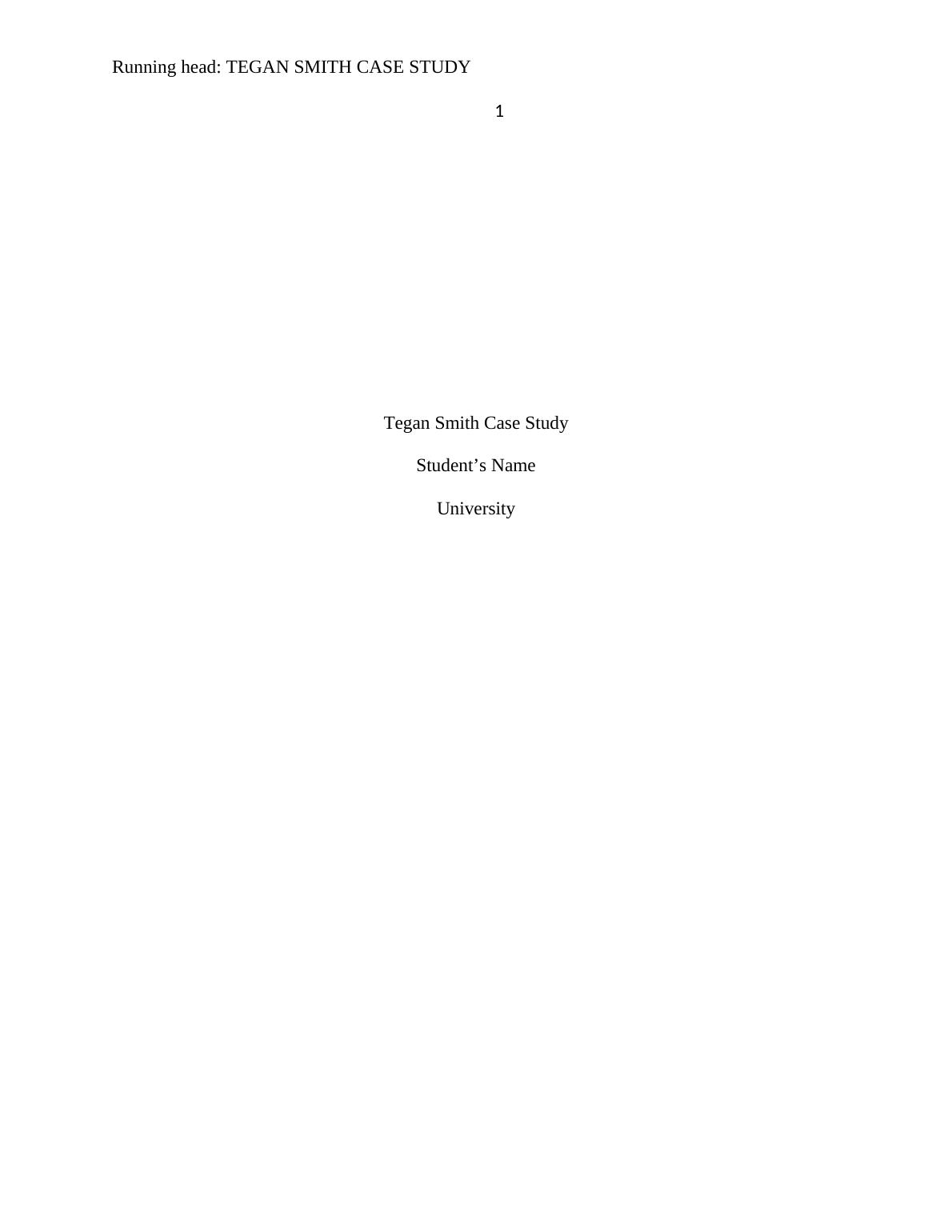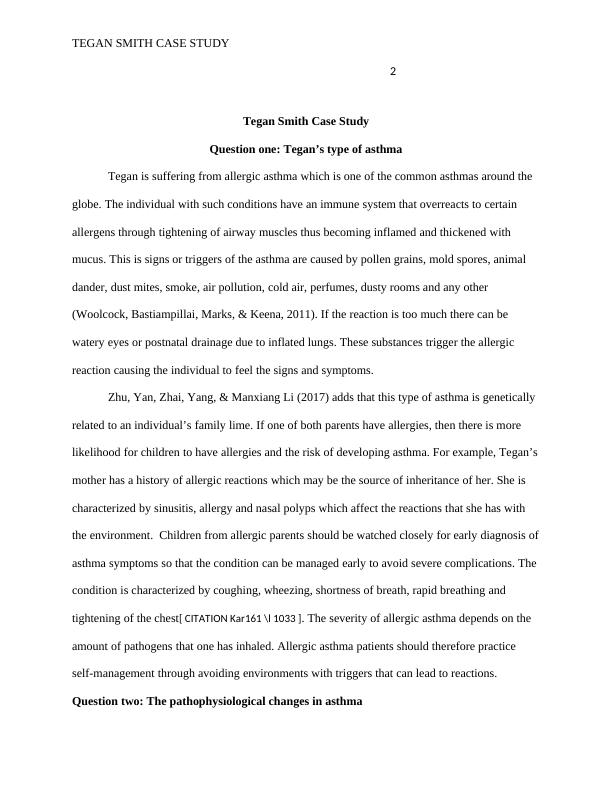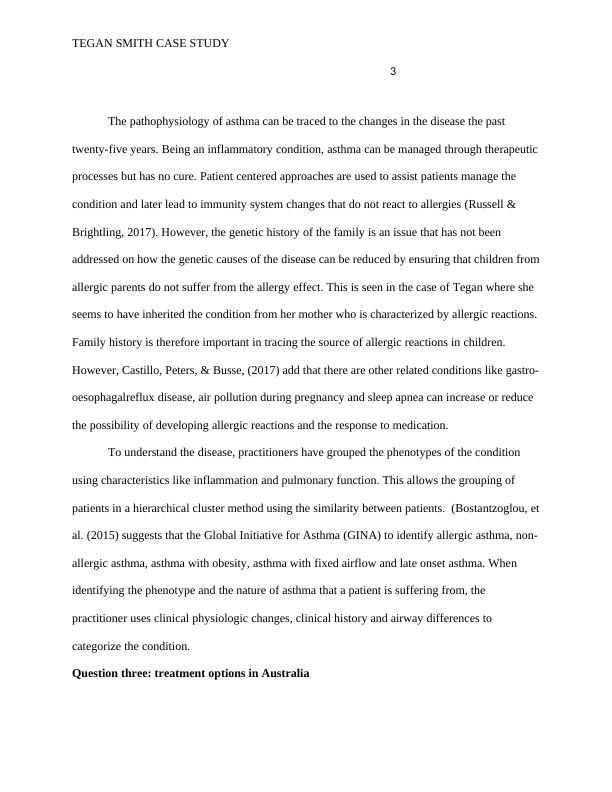(Solved) Case Study on Tegan Smith
Added on 2021-05-31
7 Pages1562 Words49 Views
Running head: TEGAN SMITH CASE STUDY1Tegan Smith Case StudyStudent’s NameUniversity

TEGAN SMITH CASE STUDY2Tegan Smith Case StudyQuestion one: Tegan’s type of asthmaTegan is suffering from allergic asthma which is one of the common asthmas around the globe. The individual with such conditions have an immune system that overreacts to certain allergens through tightening of airway muscles thus becoming inflamed and thickened with mucus. This is signs or triggers of the asthma are caused by pollen grains, mold spores, animal dander, dust mites, smoke, air pollution, cold air, perfumes, dusty rooms and any other (Woolcock, Bastiampillai, Marks, & Keena, 2011). If the reaction is too much there can be watery eyes or postnatal drainage due to inflated lungs. These substances trigger the allergic reaction causing the individual to feel the signs and symptoms. Zhu, Yan, Zhai, Yang, & Manxiang Li (2017) adds that this type of asthma is genetically related to an individual’s family lime. If one of both parents have allergies, then there is more likelihood for children to have allergies and the risk of developing asthma. For example, Tegan’smother has a history of allergic reactions which may be the source of inheritance of her. She is characterized by sinusitis, allergy and nasal polyps which affect the reactions that she has with the environment. Children from allergic parents should be watched closely for early diagnosis ofasthma symptoms so that the condition can be managed early to avoid severe complications. The condition is characterized by coughing, wheezing, shortness of breath, rapid breathing and tightening of the chest[ CITATION Kar161 \l 1033 ]. The severity of allergic asthma depends on the amount of pathogens that one has inhaled. Allergic asthma patients should therefore practice self-management through avoiding environments with triggers that can lead to reactions. Question two: The pathophysiological changes in asthma

TEGAN SMITH CASE STUDY3The pathophysiology of asthma can be traced to the changes in the disease the past twenty-five years. Being an inflammatory condition, asthma can be managed through therapeuticprocesses but has no cure. Patient centered approaches are used to assist patients manage the condition and later lead to immunity system changes that do not react to allergies (Russell & Brightling, 2017). However, the genetic history of the family is an issue that has not been addressed on how the genetic causes of the disease can be reduced by ensuring that children fromallergic parents do not suffer from the allergy effect. This is seen in the case of Tegan where she seems to have inherited the condition from her mother who is characterized by allergic reactions.Family history is therefore important in tracing the source of allergic reactions in children. However, Castillo, Peters, & Busse, (2017) add that there are other related conditions like gastro-oesophagalreflux disease, air pollution during pregnancy and sleep apnea can increase or reduce the possibility of developing allergic reactions and the response to medication. To understand the disease, practitioners have grouped the phenotypes of the condition using characteristics like inflammation and pulmonary function. This allows the grouping of patients in a hierarchical cluster method using the similarity between patients. (Bostantzoglou, etal. (2015) suggests that the Global Initiative for Asthma (GINA) to identify allergic asthma, non-allergic asthma, asthma with obesity, asthma with fixed airflow and late onset asthma. When identifying the phenotype and the nature of asthma that a patient is suffering from, the practitioner uses clinical physiologic changes, clinical history and airway differences to categorize the condition. Question three: treatment options in Australia

End of preview
Want to access all the pages? Upload your documents or become a member.
Related Documents
Case Study on Tegan Smith PDFlg...
|8
|1694
|71
Challenge and Response to Body Integritylg...
|8
|1786
|243
Understanding Allergic Asthma: Pathophysiology, Treatment and Educationlg...
|7
|1690
|115
Asthma: Pathophysiology, Treatment and Educationlg...
|7
|1665
|323
Sample Assignment on Allergiclg...
|5
|1417
|38
Respiratory System Assignment PDFlg...
|6
|1768
|41
